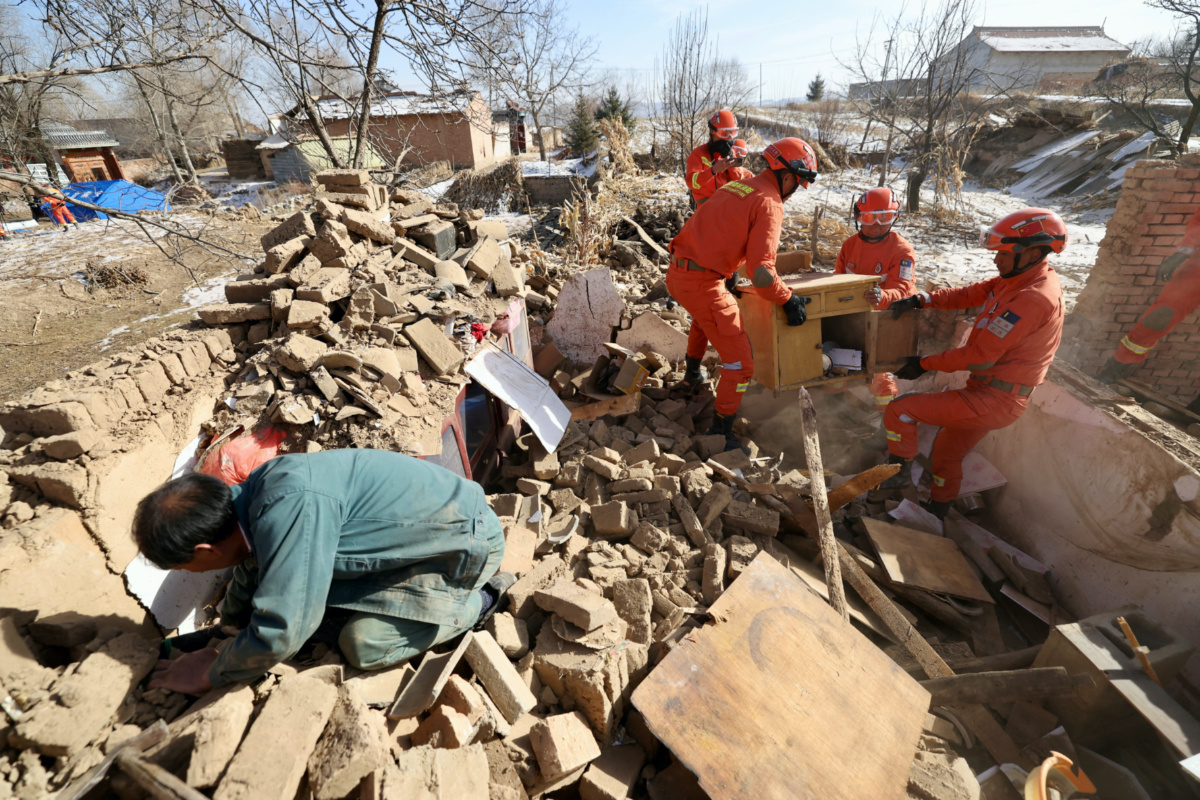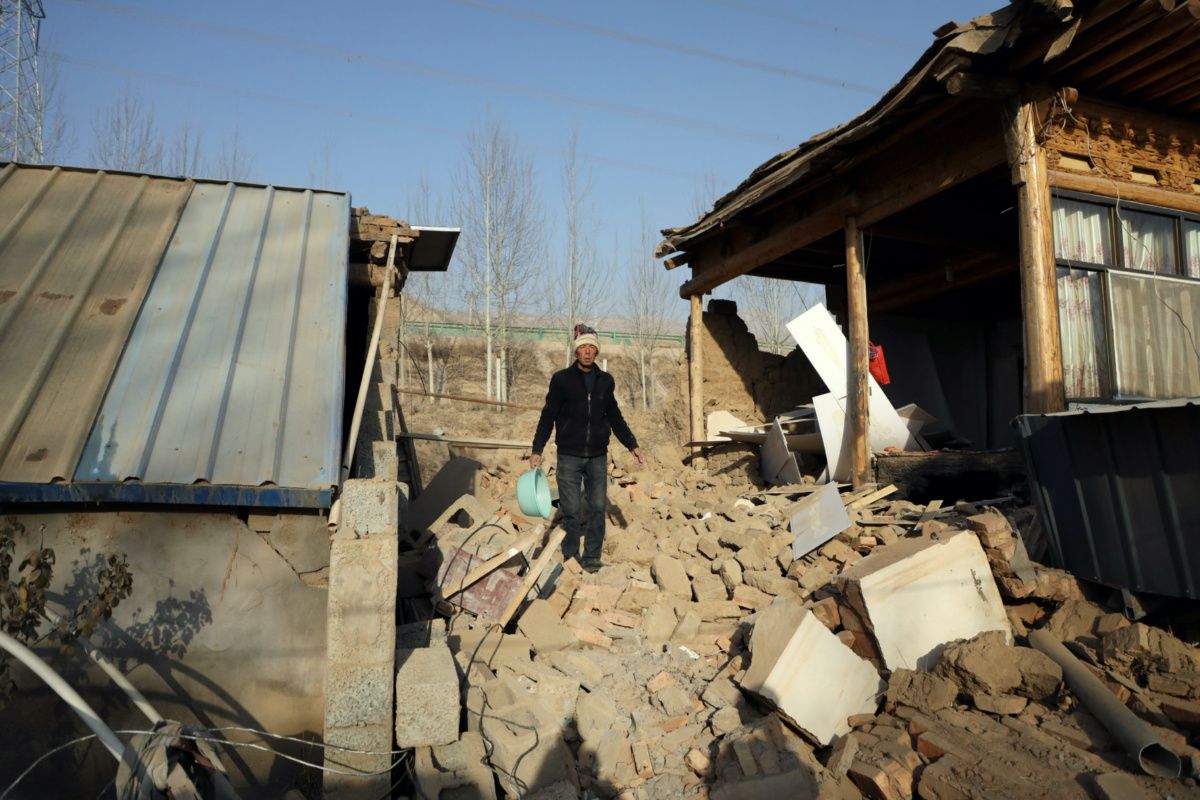Haidong, China
Reuters
Braving sub-zero cold, rescuers on Wednesday pulled to safety victims of an earthquake that rocked a remote area in China’s northwestern Gansu province, while survivors faced months of uncertainty ahead without permanent shelter.
The magnitude 6.2 earthquake jolted Jishishan county near the border straddling Gansu and Qinghai provinces a minute before midnight on Monday, sending frightened residents out of homes into the cold in the dead of the night. Roads, power and water lines and agricultural production facilities suffered damage, and the quake triggered land and mudslides.

Rescue workers retrieve belongings from a damaged house at Shiyuan village following the earthquake in Jishishan county, Gansu province, China, on 20th December, 2023. PICTURE: China Daily via Reuters
In Gansu, 113 people had been found dead as of 9am on Wednesday and 782 were injured, authorities said. The death toll in neighbouring Qinghai rose to 21 with 186 injured and 13 missing as of 4pm on Wednesday.
Seventy-eight people have been found alive in Gansu, where rescue operations ended on Tuesday afternoon, Chinese media said, as the focus shifted to treating the wounded and resettling residents as a months-long winter loomed.
It was not immediately clear whether the search in Qinghai had ended or not.
In Gansu, more than 207,000 homes were wrecked and nearly 15,000 collapsed, affecting more than 145,000 people. More than 128,000 emergency supply items including tents, quilts, tent lights and folding beds were delivered while food such as steamed buns and instant noodles were provided to the victims.
The quake-stricken area is geographically a transition zone between two plateaus, featuring terrains of altitudes ranging from 1,800 to 4,300 metres with “very complex” topography, CCTV said.
The post-quake recovery has been further challenged by an intense cold snap that has gripped most of China since last week. Temperatures around the quake epicentre in Gansu fell to about minus 15 degrees Celsius on Tuesday night.
According to local media citing researchers, people trapped under rubble exposed to minus 10 degree conditions without help are at risk of rapid hypothermia and may only be able to live for five to 10 hours even if uninjured.
In Qinghai’s quake-hit Haidong city, Du Haiyi said his family home had been completely levelled. The 21-year-old told Reuters he had managed to save his mother and 16-year-old sister, who were trapped under debris the night of the quake.
“My parents were pulled out from underneath this, but I don’t know how,” Du said. “We ran to wherever we could.”
Du, an occasional labourer, said his family of seven had slept exposed to the elements with neither sustenance nor adequate covers, taking shelter in a tent provided by the local government.

A man walks on the rubble next to a damaged house following the earthquake that rocked Gansu’s Jishishan county, in Haidong, Qinghai province, China, on 20th December, 2023. PICTURE: Reuters/Xiaoyu Yin
Homeless in winter
Those who lost homes had few options but to gather in fields, burning wheat straw for warmth. One family of seven took refuge in a car for the night as emergency tents were prioritised for the elderly and young, Beijing Youth Daily reported.
Within 50 kilometres of the quake epicentre on the edge of Qinghai province, the earthquake affected 22 towns and villages, but of that, two villages suffered the worst damage.
The county of Minhe in Haidong earlier recorded 20 missing people from two villages, where a mudslide swept through, half-burying many buildings in brown silt. Search and rescue operations and efforts to resettle residents were complicated as mud blocked main roads, state media said, showing footage of bulldozers clawing through mud and rubble.
“We have prepared coats with extra cotton, like military coats, and then some things to keep warm like heating equipment,” said Wu Saying, 21, a rescue volunteer in Haidong.
Food supplies were also a concern.
“I didn’t have anything to eat yesterday, and today I’m eating the food left in the house,” said Bao Yinzi, 53. “The pot is buried, the bowl is buried. There’s nothing left.”
We rely on our readers to fund Sight's work - become a financial supporter today!
For more information, head to our Subscriber's page.
Aftershocks
The frigid cold was not the only concern weighing on rescuers and working groups assessing the situation.
The Gansu Provincial Seismological Bureau said strong aftershocks of magnitude 5 were still possible around the area in the coming days, based on the characteristics of Monday’s quake, historical seismic activity and other factors.
The aftershocks will be closely tracked so as to issue early warnings, the official Chinese news agency Xinhua cited the bureau’s deputy director as saying.
Wu, the volunteer, said villagers whose homes were seriously damaged were given tents. He said he was worried about aftershocks.
By early Wednesday, there were two aftershocks of magnitude 4.0 and above, and eight of magnitude 3.0 and above, the China Earthquake Networks Center said.
The quake centred in Gansu’s Jishishan county was logged at a depth of 10 kilometres, which experts consider shallow. Earthquakes with shallow focal points can easily cause considerable damage to the ground, Xinhua reported citing a senior engineer with the China Seismological Network Center.
Earthquakes are common in Chinese provinces such as Gansu, lying on the north-eastern boundary of the tectonically active Qinghai-Tibetan plateau. China’s deadliest quake in recent decades was in 2008 when a magnitude 8.0 temblor struck Sichuan, killing nearly 70,000 people.
– With reporting by the Shanghai newsroom






